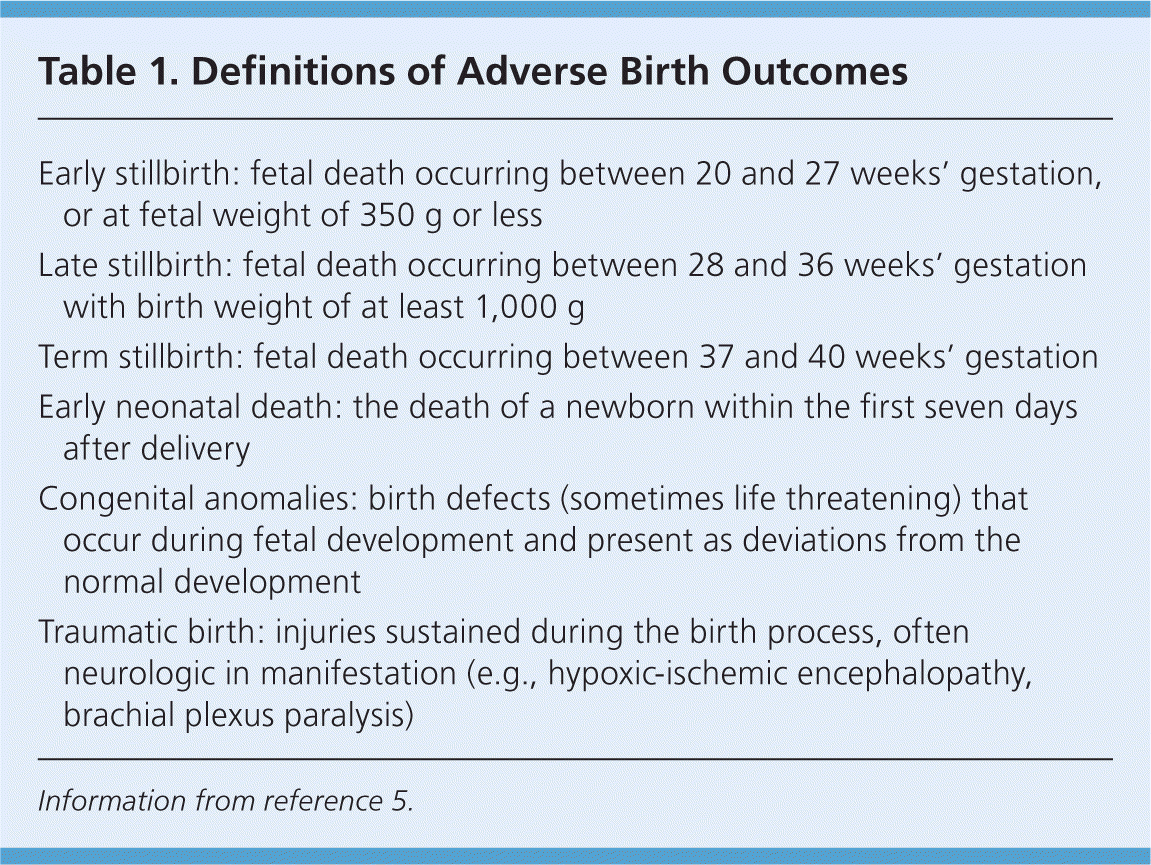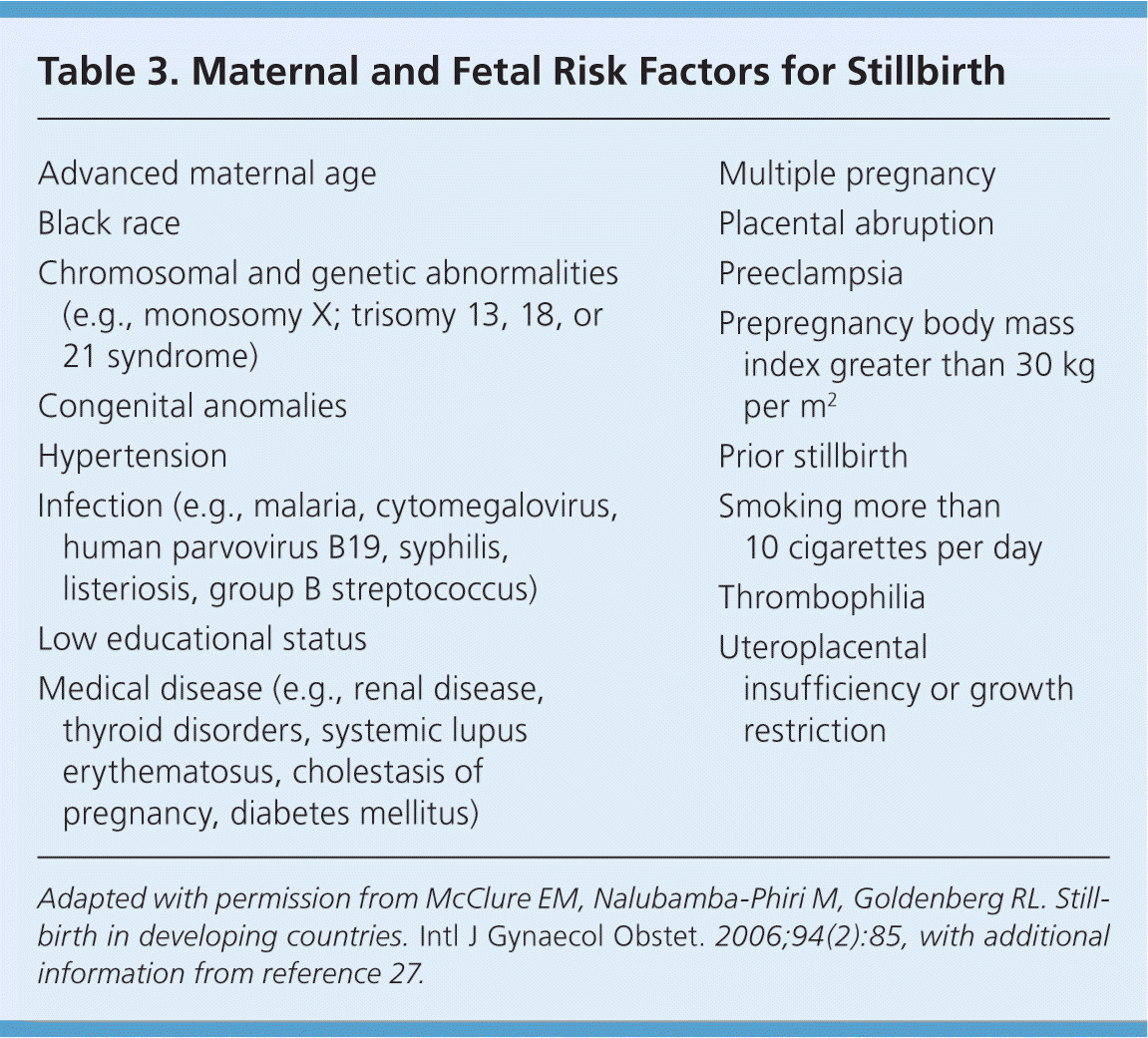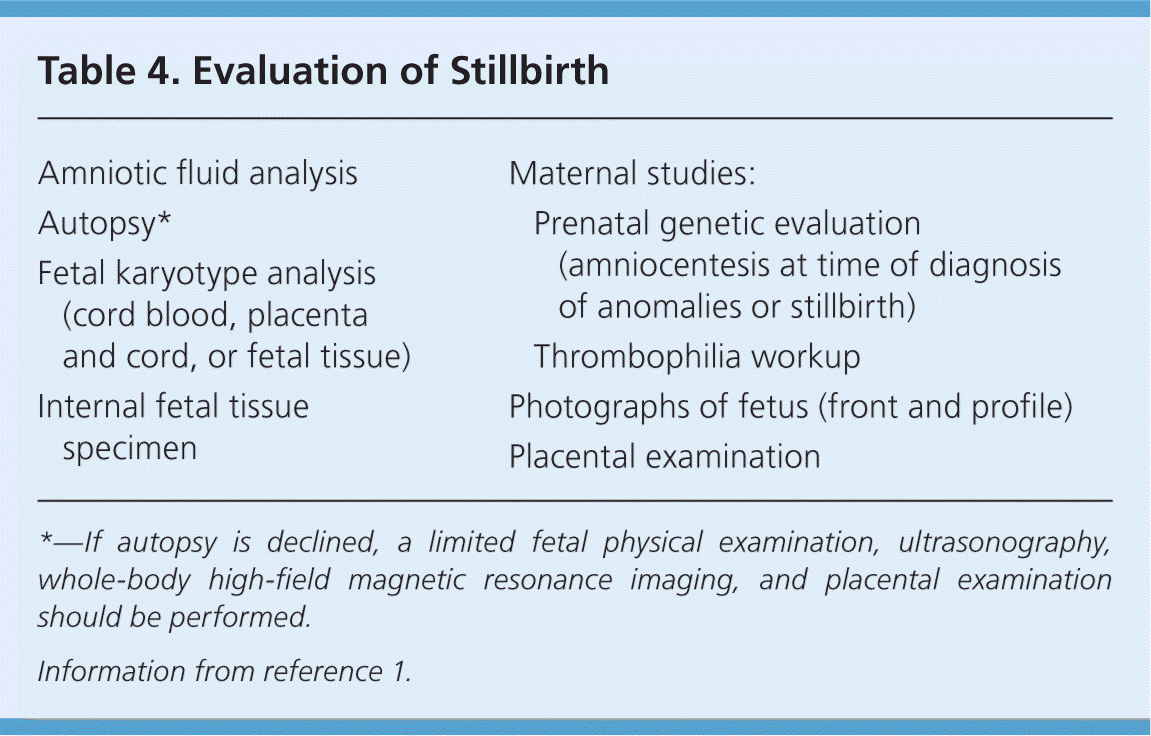
Am Fam Physician. 2012;85(9):900-904
Patient information: See related handout on pregnancy loss, written by the authors of this article.
Author disclosure: No relevant financial affiliations to disclose.
Unexpected adverse fetal and neonatal outcomes (e.g., stillbirth, birth trauma, congenital anomalies) present a crisis for the family and the medical care team. In cases of stillbirth, the family physician should be flexible in supporting the parents' choices, validate the loss, and work as a team with the nursing staff. Psychosocial support includes offering counseling services, assessing women for postpartum depression and anxiety, and considering the effect of the loss on the entire family. Although infants with birth asphyxia or major anomalies may require transfer to facilities with a neonatal intensive care unit, the physician will usually provide ongoing care for the mother in the postpartum period. A comprehensive assessment can determine the etiology of fetal demise in most cases, which may guide future preconception and maternity care. Women with a previous adverse pregnancy outcome may have increased psychological stress in a subsequent pregnancy. Knowledge of community resources will facilitate care for the mother and her partner or family. Physicians may need to seek peer support to cope with their own feelings of loss.
Most parents and medical professionals expect a normal labor and delivery, with a healthy infant as an outcome. Family physicians who provide prenatal, maternity, or postpartum care are likely to confront an unexpected adverse birth outcome during their professional career. Intrauterine fetal demise (i.e., stillbirth) occurs in 6.2 of every 1,000 pregnancies.1 Deviations from a healthy pregnancy or birth may trigger feelings of loss for the parents and the physician. Parents may recall, many years after the event, the words used by the physician, and his or her ability to interact with them.2–4 The attitudes and skills of the physician may affect the parents' comfort level with ongoing management and their ability to trust that their infant will receive the best care possible.3 This article discusses psychosocial management of and adjustment to adverse birth outcomes (Table 1).5
| Clinical recommendation | Evidence rating | References |
|---|---|---|
| Although lack of emotional support and grief acknowledgment for mothers after a perinatal loss increases the risk of poor attachment in subsequent pregnancies, no specific psychological support or counseling can be recommended based on current evidence. | C | 7 |
| A comprehensive assessment to determine the etiology should be offered after a stillbirth. | C | 25 |
| In subsequent pregnancies after a fetal demise or perinatal loss, women may benefit from additional prenatal visits for genetic counseling, assessment of anxiety, ultrasonography, and prenatal fetal assessment. Daily fetal movement assessment is recommended in the third trimester. | C | 1, 25, 33, 34, 36 |

| Early stillbirth: fetal death occurring between 20 and 27 weeks' gestation, or at fetal weight of 350 g or less |
| Late stillbirth: fetal death occurring between 28 and 36 weeks' gestation with birth weight of at least 1,000 g |
| Term stillbirth: fetal death occurring between 37 and 40 weeks' gestation |
| Early neonatal death: the death of a newborn within the first seven days after delivery |
| Congenital anomalies: birth defects (sometimes life threatening) that occur during fetal development and present as deviations from the normal development |
| Traumatic birth: injuries sustained during the birth process, often neurologic in manifestation (e.g., hypoxic-ischemic encephalopathy, brachial plexus paralysis) |
Psychosocial Concerns
An adverse birth outcome can trigger anxiety as parents attempt to cope with the crisis.4 Grief can be devastating to the parents; the stillborn infant represents the loss of their future, “the world that should be.”4 Although individual reactions are determined by cultural and religious beliefs, the birth crisis typically causes fear and worry as the family adapts.4 Sociocultural expectations of grief for varying gestational ages may not be congruent with the parents' experience.3 Some women have unexpected and profound grief after a first miscarriage.3,4 Lack of supportive emotional care, insensitivity, poor communication, and avoidant behaviors by physicians or nurses can increase emotional distress and resentment in parents and other family members.3,4 Physicians must focus on the emotional needs of all involved when addressing maternal and neonatal medical requirements after an adverse birth outcome.4–6
A 2008 Cochrane review noted that there were not adequate data from randomized controlled studies to determine specific psychological support or counseling needs for parents and families after perinatal death.7 Even after counseling, many families report receiving inadequate emotional support from their physician.6,8 Women whose pregnancy was complicated by isolation or secrecy often have more severe depression and difficulty coping.9 Studies have identified issues related to “disenfranchised grief,”10 which is mourning complicated by lack of usual societal norms (e.g., funerals, time off work for fathers) and lack of support from the medical community.8,9,11 For some families, the pregnancy loss may be perceived as a failure to provide for the future and inadequacy in fulfilling the basic role of procreation.8 Specific cultural responses may be varied and difficult to interpret.5,11
There is controversy about the effects of allowing the mother to hold her stillborn infant; some studies suggest that it can result in disorganized attachment and subsequent anxiety over the loss.4,11 Continuing to weave the memories of those babies into the fabric of their families' lives is critically important for future grief resolution.11 There is probably no single correct response to perinatal loss, but physicians must allow the parents to decide what feels right for them, and support their wishes.6,8
Initial Management
When meeting with parents at the time of an adverse birth outcome, the physician must recognize that some parents will need several meetings to fully understand and absorb what has happened12,13 (Table 214 ). The physician should emphasize early in the conversation that inability to recall information often occurs, and that repetition is important in subsequent meetings.15 At the initial meeting, the physician should avoid providing more information than the parents can comprehend at that time.16 Communication with the nursing staff is important because parents often ask nurses for clarification after the physician leaves the room.17–19 Physicians should ask nurses how the patient feels about holding the infant, who is staying with the patient, and whether any other information or support can be provided.6,20 Physicians should plan to spend sufficient time in the room initially, listening and answering questions, then arrange a time to meet the following day for additional discussion.18,21

| Meet with family members as soon as possible |
| Sit at eye level |
| Call infant by name |
| Avoid medical jargon |
| Inform both parents together, assure privacy, encourage attendance of support person as soon as possible after crisis presents |
| Allow parents to express feelings |
| Recognize that guilt and self-blame are common |
| Avoid assignment of blame or premature diagnostic labels |
| Review facts but acknowledge their limits |
| Recognize that parents must attach before letting go, and that parental grief may be equal but expressed differently (maternal reactions are based on degree of prenatal attachment, whereas paternal reactions are based on connectedness to pregnancy, a sense of fatherhood, and the image of the infant) |
| Encourage parents to see and hold the infant |
| Review normal developmental aspects of the infant |
| Offer mementos such as footprints, hair, photographs |
| Plan timing of follow-up meetings |
| Reassess family needs |
| Attend to emotional concerns |
| Monitor maternal health |
| Address financial issues |
| Anticipate anniversary grief |
If the infant must be transferred to a tertiary care center, a discussion about advance directives, organ donation, intubation, or blood transfusions may be necessary before the move.19 If the mother and infant will not be in the same hospital, a follow-up appointment can be scheduled for the physician to meet with other family members to review processes and options, and to continue to provide support.14,21 Physicians should avoid predicting the outcome or course of events.14,22 Decision making may be adversely affected as a result of shock and, for the mother, a sense of overwhelming physical change.14
Cultural and personal beliefs should be evaluated early in the process, particularly for families who may feel estranged from mainstream values.14,21 The physician should provide information in a nonjudgmental, empathic tone and avoid assumptions about the family's choices.23 All family members should be considered collectively and individually.14,23
Severely Ill Infant
When it is anticipated that an infant will not survive or will have severe long-term medical problems, the physician can provide support, assist in decision making, and provide personal space to allow the family to bond with and say farewell to their infant.14,19 Family members should have liberal access to their infant during the process of dying.23 During this time, it is important to be realistic without eliminating hope.14 Challenging issues such as organ donation and withdrawal of life support should be discussed.14,19 It is important that these be team decisions based on the best interests of the child, thereby eliminating the need for the parents to make the decisions alone.19
Stillbirth
Stillbirth occurs in one in 160 pregnancies in the United States, with racial disparities; this rate is higher than in many other developed nations.24 Patterns of stillbirth have changed as the ability to manage Rh hemolytic disease, diabetes mellitus, and hypertension has improved.22,25 Many anomalies that in the past would have resulted in stillbirths can now be identified prenatally, allowing for the possibility of elective pregnancy termination.22,25 Maternal and fetal risk factors for stillbirth are listed in Table 3.26,27

| Advanced maternal age |
| Black race |
| Chromosomal and genetic abnormalities (e.g., monosomy X; trisomy 13, 18, or 21 syndrome) |
| Congenital anomalies |
| Hypertension |
| Infection (e.g., malaria, cytomegalovirus, human parvovirus B19, syphilis, listeriosis, group B streptococcus) |
| Low educational status |
| Medical disease (e.g., renal disease, thyroid disorders, systemic lupus erythematosus, cholestasis of pregnancy, diabetes mellitus) |
| Multiple pregnancy |
| Placental abruption |
| Preeclampsia |
| Prepregnancy body mass index greater than 30 kg per m2 |
| Prior stillbirth |
| Smoking more than 10 cigarettes per day |
| Thrombophilia |
| Uteroplacental insufficiency or growth restriction |
Physicians should offer a comprehensive assessment of the stillbirth, because a complete evaluation will often be able to determine a cause 1,22,25 (Table 41 ). In a retrospective study of 196 antepartum fetal deaths, a cause of death was determined in 60 percent of cases.25 A population-based study of 500 stillbirths with postmortem examination conducted by the Stillbirth Collaborative Research Network demonstrated a probable cause in 60.9 percent of cases, and a possible or probable cause in 76.2 percent.28 The most common causes were obstetric conditions (29.3 percent; e.g., placental abruption, complications of multiple gestations, preterm labor or rupture of membranes), placental abnormalities (23.7 percent), genetic or anatomic anomalies (13.7 percent), infection (12.9 percent), umbilical cord abnormalities (10.4 percent), and hypertensive disorders (9.2 percent).28 An autopsy is the most useful test to determine the cause of stillbirth,1 followed by placental examination. The Stillbirth Collaborative Research Network recommends that a postmortem examination with placental histology and karyotype be performed after all stillbirths because at least one of these tests is positive in 66 percent of cases.28 Laboratory tests for infections and thrombophilia may be indicated based on the clinical presentation.1 A review of maternal history and the prenatal course may identify risk factors that can be modified in subsequent pregnancies. Chromosomal analysis may be obtained by amniocentesis when intrauterine fetal demise or fetal anomalies are diagnosed.22 Genetic testing may also be performed postpartum using placental tissue or fetal blood.1

| Amniotic fluid analysis | |
| Autopsy* | |
| Fetal karyotype analysis (cord blood, placenta and cord, or fetal tissue) | |
| Internal fetal tissue specimen | |
| Maternal studies: | |
| Prenatal genetic evaluation (amniocentesis at time of diagnosis of anomalies or stillbirth) | |
| Thrombophilia workup | |
| Photographs of fetus (front and profile) | |
| Placental examination | |
Effects on Future Pregnancies
Studies have documented increased psychological distress during subsequent pregnancies when grief over a previous adverse birth outcome had not been acknowledged or resolved through normal socially approved processes.2,29 Asynchronous grief between the parents may also lead to discordant recovery and varying expectations.20,23 Sleep disturbances are common in the six months after a pregnancy loss and may require short-term treatment with hypnotics or sedating antidepressants. Some women need more intense treatment for postpartum depression.6,20 In a study of 66 women in the United Kingdom with a history of stillbirth, the lifetime prevalence of posttraumatic stress disorder was 29 percent, and the prevalence during a subsequent pregnancy was 20 percent.30 The use of antidepressants and psychotherapy has not been evaluated in the context of perinatal loss.
Women who conceive within six months after a pregnancy loss have a higher risk of adverse maternal and fetal outcomes compared with those who conceive later.29,30 Increased anxiety and more severe depression may occur if the new pregnancy overlaps the anniversary of the previous loss, or if the joy of a subsequent pregnancy interferes with the ability to grieve the loss of the previous pregnancy.6,31 During the subsequent pregnancy, it is important that women feel they can discuss any ambivalence with their physician.31,32
An analysis of risk factors, including maternal age and medical conditions, is useful when a subsequent pregnancy is planned.25 Factors significantly associated with recurrent stillbirth include placental abruption, antiphospholipid antibody syndrome, and low birth weight.33,34 Modifiable risk factors should be reviewed, but the physician should take care to avoid assigning blame for previous stillbirths.25 There are multiple risk factors for stillbirth that can be identified at the time of pregnancy confirmation, including non-Hispanic black race, nulliparity, prior stillbirth or miscarriage, tobacco use, and maternal diabetes. However, the positive predictive value of these factors is low and they account for only a small proportion of the risk of stillbirth.35 The incidence of recurrent intrauterine fetal demise may be decreased by implementation of smoking cessation programs, evaluation of fetal anomalies, diagnosis and surveillance of intrauterine growth restriction, induction of postterm pregnancy, and use of daily fetal movement assessment in the third trimester.33,34,36
Effects on Other Family Members
The effect of adverse birth outcomes on fathers, siblings, and grandparents has received little scrutiny.37 Fathers have reported self-blame, a loss of identity as a father, and a need to hide their feelings after a perinatal loss.37,38 They may have to inform family and friends of the loss and plan the funeral, yet society may not fully recognize the extent of their grief and often does not provide them the same support accorded the mother.7,38,39 Children may fantasize about the events and make conclusions about the cause, at times blaming themselves or the parents.6 Adolescents may need age-specific support,39 and a child born after a pregnancy loss may experience sequelae such as poor attachment to the grieving mother.31,32 As care providers for different family members, family physicians are well placed to provide resources for family support.39
Personal Response of the Physician
Physicians may feel isolated in their own grief and have difficulty providing appropriate support to families after a perinatal loss.40 This reaction may be particularly acute in smaller communities where neighbors and friends are patients.39,40 Physicians may question their own actions during the pregnancy and birthing process, and feel some responsibility for the outcome. This may engender feelings of guilt, as well as disabling fears of litigation. It is important for the physician to obtain support from colleagues and family, and to work within the social and professional support systems provided. Supportive collegial feedback is a safe arena in which to review the issues surrounding the case and come to closure.40
